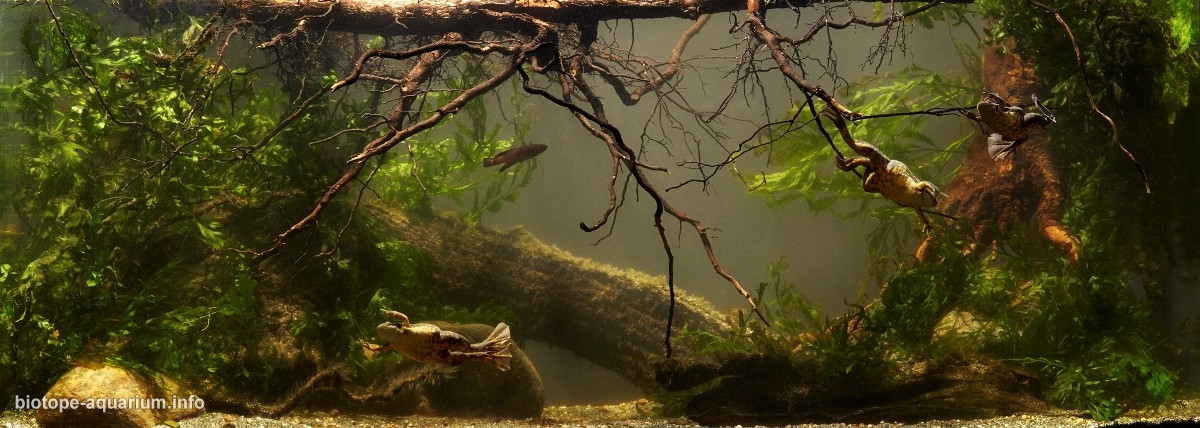Masek Lake, margin near the village of Sinoni, Tanzania, Africa
76th place in Biotope Aquarium Design Contest 2019
Russia. Matvey Sokolov

Volume: 120 L
Dimensions: 79.5×42.5×35 cm
List of fishes: Xenopus Borealis, Nothobranchius korthausae
List of plants: Bolbitis heudelotii
Description of decorations: Mangrove driftwood, pine and chokeberry roots, gray rounded stones, fine gray sand
Description of equipment: AQUAEL TURBO FILTER 500, heater AQUAEL COMFORT ZONE FIX 75W, TETRA Tetronic LED ProLine 780 lamp
Water parameters: temperature 25 degrees, pH 6.5, KH 3, NO3 – 30 mg / l, NO2 – 0
Additional info: Change of 25% of the volume of water is made every 10 days. Kenyan frogs feed mainly on invertebrates and do not touch fish as large as Nothobranchius. Seasonal kallifish and Xenopus borealis can be found together, because they both prefer shallow water with soft silty soil and shelters – plants, roots that allow them to hide from birds (herons, kingfishers), which are their natural enemies. In the future we plan to plant other types of Nothobranchius in this aquarium.
INFORMATION ABOUT BIOTOPE
Description of the area surrounding the biotope: Lake Masek is a small, strip-shaped lake located near the western border of the Ngorongoro Conservation Area in northern Tanzania. It serves as a source of drinking water for animals and for residents of campgrounds in the district. Its shallow depth makes it seasonal, as it loses most of its area during dry seasons or long droughts. It, along with neighboring lands, serves as a source of water for the river, which flows through the famous Olduvai Gorge. The Masek Lake basin is located near the beginning of the Olduvai Gorge, near the border between the Ngorongoro Conservation Area and the Serengeti National Park. The ecosystem of the Serengeti region is one of the oldest and best preserved on Earth. Protected areas occupy more than 80 percent of the Serengeti: the Serengeti National Park, the Ngorongoro Conservation Area in Tanzania, the Masai Mara Nature Reserve in Kenya, and others. The Serengeti is located at an altitude of 920 to 1850 m above sea level, and its landscape changes from the grassy plain in the south to the savannah in the center and vast woodland in the west. Serengeti’s climate is usually dry and warm. The main rainy season is from March to May, and light rains occur from October to November. Precipitation increases from 508 mm on the plains covered by the Ngorongoro Upland to 1,200 mm on the shores of Lake Victoria. More than 4.5 million wild ungulates (antelopes, zebras, buffalos, rhinos, giraffes, hippos) live in the Serengeti, elephants, lions, cheetahs, leopards, hyenas, etc. are common. There are many campgrounds on Lake Masek; tourists often come to observe the migration of animals. Every year in May, two and a half million herbivores, mainly wildebeests, accompanied by antelopes and zebras, travel for several months from the meadows in the south of the Serengeti to the Masai Mara nature reserve in the north.
Description of the underwater landscape of the biotope: Pebble-sand coast covered with driftwood and coastal plants. The silted dark bottom abounds with snags serving as shelters for small fish and amphibians.
Description of the parameters of the habitat: Water is soft, slightly acidic, unclear, many plants, driftwood.
List of fishes and invertebrates occurring in the nature biotope: Nothobranchius elongatus
Nothobranchius palmquisti
Nothobranchius foerschi
Nothobranchius cardinalis
Nothobranchius eggersi
Nothobranchius flammicomantis
Nothobranchius kilomberoensis
Nothobranchius lourensi
Xenopus Borealis
List of plants found in the nature biotope: Vallisneria spiralis
Bacopa Monnieri
Hymenasplenium obscurum
Philonotis hastata
Ceratopteris cornuta
Threats to the ecology: Deforestation, immoderate fishing, which destroys local biotopes, takes place here.
Sources of information:
https://amphibiaweb.org/cgi/
http://fishbase.sinica.edu.tw/
http://biotopfish.com/genus/
https://zooclub.ru/rybki/vidy-
https://houseaqua.ru/848-
https://forums.zooclub.ru/
https://www.inaturalist.org/
https://aquarium-fish-home.ru/
http://www.geography.su/atlas/
Plants info: https://www.aqvium.ru/vidy-
https://forums.zooclub.ru/
Book by Krissel Kasselman “Atlas of aquarium plants”
